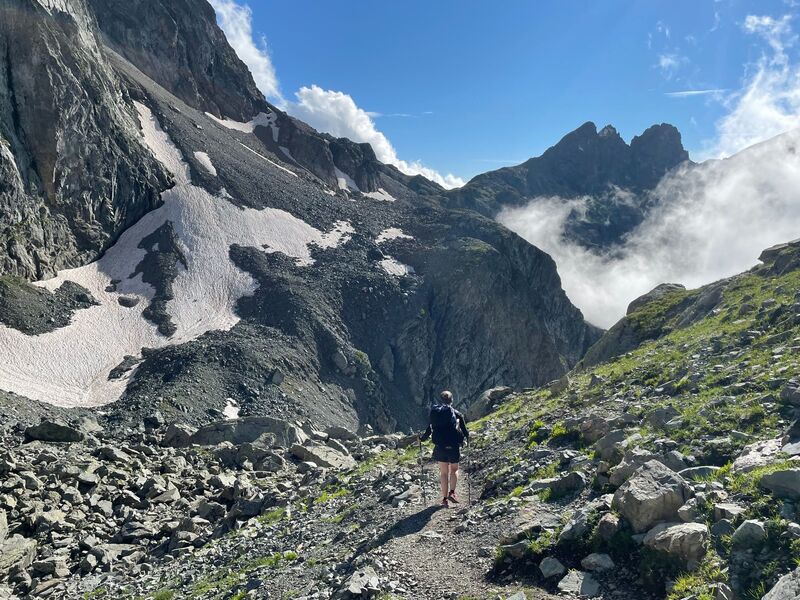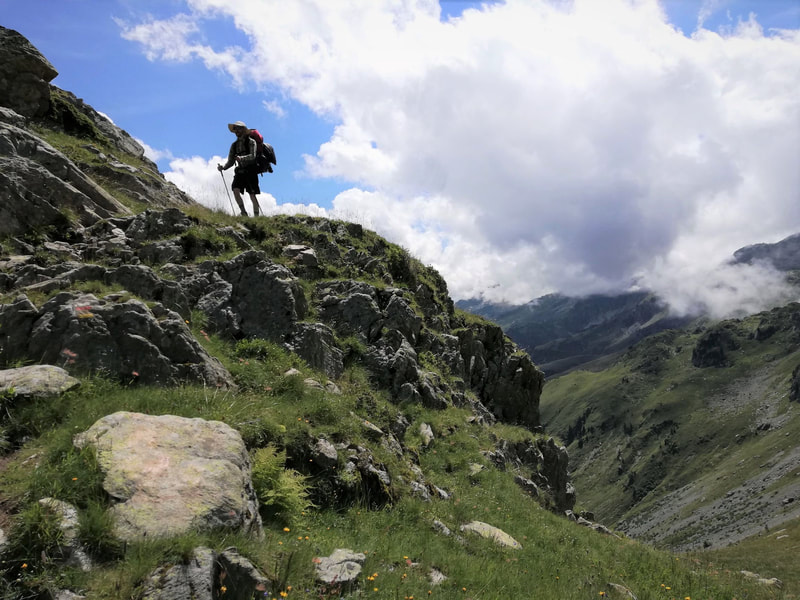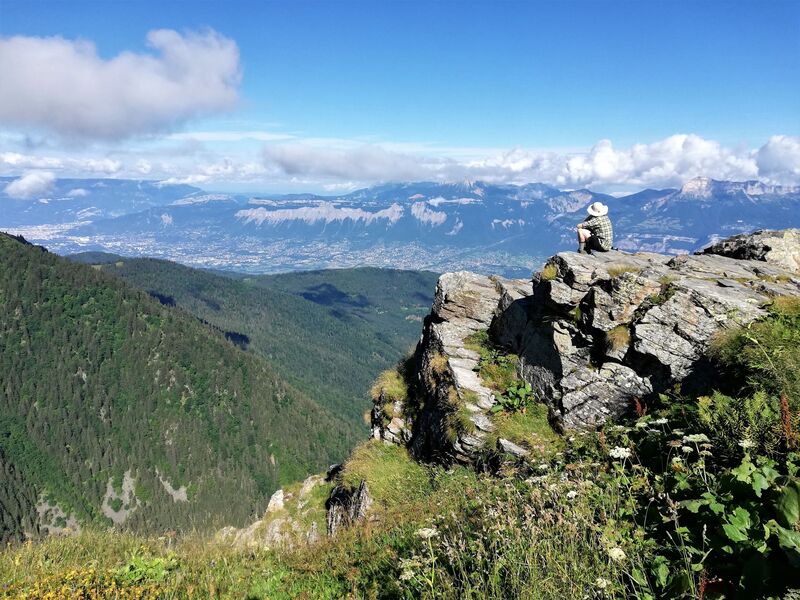|
The sensation of dry feet feels like a distant memory after four rainy days on the GR 738. But on day five, I can pat myself on the back for making it through the solo part of my adventure. At the popular lodge La Martinette, a Belgian companion is waiting for me. In addition to good morale, Stefaan is bringing four days worth of food – a welcome resupply on a trail that does not pass through many towns. Sleepover parties with Pierre, Pierre and the 1970s Larousse After a warm night at La Martinette, we put on our rain gear to defy the showers coming at us from all sides on our 1.200 metre ascent towards the Refuge des Sept Laux. Above the treeline, the trail has transformed into an icy stream reaching up to our ankles. Soaked to the bone and shivering, we knock on the door of the fully booked refuge three hours later, but the grumpy staff show no remorse. Commanding us to wait outside, they collect our money and hand over the key to a dilapidated shed ten minutes away. “At least we’ll have a roof over our heads,” I cautiously try to salvage the situation. With red, swollen hands, I frantically peel off my wet clothes when we stumble inside. Stefaan picks a battle with the fire stove, while I crawl into my sleeping bag and wait for my extremities to regain some sensation. My feet finally start to tingle when we are joined by butcher Pierre and teacher Pierre, our new housemates. Pages ripped from a 1970s Larousse help keep the fire alive all evening. With the remainder of the encyclopedia, Pierre and Pierre subject us to a challenging game of guessing which word they read the description aloud to. Malheureusement, our grasp of the French language is not quite up to par. What could have been a miserable night in our tents, turns into a candle-lit sleepover party instead, with a three-course meal followed by a couple of beers – I did learn how to hike like the French just two days ago. The cherry on top of the cake is the starry 4 AM sky that heralds a better weather window for the coming days. Un pierrier de merde A humble rainbow brightens up the chilly morning, as we hike past several lakes. Though we only have one outfit on us, we manage to change multiple times an hour by putting on and taking off layers. I wonder what the birds must think of our constant metamorphosis, knowing all too well the answer is probably nothing at all. Nature couldn’t care less, which is one of the things I love about it. To avoid the remaining snow patches, we take a little detour and hop from one rock to the next all the way up to the Col de la Vache, where a griffon vulture circles overhead in search of carrion. A middle-aged hiker approaches from the opposite valley: “Good luck with your descent,” he snorts, “a pierrier de merde awaits you on the other side.” A serious scramble does require our utmost attention going down, but spotting a sunbathing chamois and a furry marmot family makes the effort worthwhile. Under the setting sun, we set up camp on a patch of grass by a little stream and enjoy our bivouac’s stillness with Grenoble’s gentle glow in the valley behind. For the love of crackers We take our time getting ready in the morning, while the sun dries our tents. Descending past the Refuge Jean-Collet, we admire the extensive views over the Chartreuse before toiling up a steep hill to the Col de la Sitre. With two gorgeous valleys stretching out on either side of the rim, I feel on top of the world both physically and mentally. By the Lac du Crozet, we run into our new pal Robert and his friends once again. “Are you excited to have tarte aux myrtilles at the Refuge de la Pra soon?” Thibaut beams. Unaware that blueberry pie was even an option, we are indeed thrilled by the prospect. Eventually, it is the fresh crepes on the sugar-ridden menu that manage to seduce us. We team up for a group bivouac by the Lacs Robert, trading our parmesan and olive oil for sips of beer. As the crackers and Nutella jar make their way around the circle, eyes close in pure delight at so much goodness. A spirited round of “Zhe Game” and some star gazing top off the night. All that separates us from society is a short descent to ski resort Chamrousse, where pop music blasts through giant speakers. Tourists stroll past market stalls selling regional produce, while their shrieking offspring go nuts on a Spongebob-shaped bouncy castle. A minute ago, we were tracing our way through a herd of goats. Now, days’ worth of unanswered texts light up our phones and I cannot help but stare at waitress' fake eyelashes as she takes our order. “Life in the mountains has its own pace,” I sigh. But my melancholy is short-lived, evaporating the minute our crepes and cappuccinos are served. Before we hop on the bus to Grenoble, I make sure to pick up a bottle of génépi from the market – a little something to ease the mountain nostalgia back home, just in case ... Practical info
0 Comments
A month after leaving the Pyrenees, I already find myself heading south again. This time, Fadi and I plan to hike the GR5/GR55 from Landry to Briançon in the French Alps. "Don't worry, they're not live bullets" After stacking up on pains au chocolat and other essentials in the small town of Peisey-Nancroix, we head to the Palais de la Mine. This 18th century lead and silver mine mainly used to serve military interests. While the site is derelict today, the military presence is still a fact. Camouflaged snipers march past on their training day and when the shooting intensifies, an officer reassures us: “Don’t worry, they’re not live bullets.” Leaving society behind, we enter the Parc National de la Vanoise and get acquainted with its population of cows and marmots. The view of the glaciated dome of La Grande Motte in the distance rewards us for the long climb before we set up our tent by the beautiful Lac de la Plagne. The next day, the promise of a supermarket in Tignes helps us brave the frigid early morning temperatures. After climbing over the Col du Palet, a signpost prematurely informs us that the ski resort is a mere 20 minutes away. When we finally arrive 45 minutes later, hunger once again proves to be the best sauce as it turns our groceries into a feast. The town is eerily quiet outside of winter season, so we happily resume our climb through the national park and set up camp by the charming Refuge de la Leisse. Love at first sniff Our first encounter with patous awaits when the trail leads us down to the valley the next morning. These mountain dogs are trained to guard sheep and their white coats allow them to disappear in the crowd entirely, hence the advice to always walk around a grazing herd. As the sheep occupy the entire mountain flank, however, we have no choice but to move slowly and talk gently, hoping this will put their protectors at ease. Luckily, a few sniffs suffice for the dogs to categorise us as harmless, so no objection is made to our passage. Their professionalism stands in stark contrast to more aggressive encounters we've had with shepherd dogs in the past. Instead of barking and growling, they remain calm and focused. A steep climb brings us to the Col de la Vanoise, while menacing clouds announce a storm. We hastily descend, only stopping to have lunch when our campsite appears in sight. When a fine sample of lunch foods emerges from our backpacks, the Lac des Vaches soon honours its name: a curious cow confidently strides towards us and gives my phone and hand sanitizer an inquisitive lick, before examining our pasta, crackers and cheese. I learn exactly how long a cow tongue is, as I narrowly dodge hers while stuffing everything into my pack. Soon after we set up the tent, the storm breaks loose. The mountains are blanketed in a dense fog and eventually disappear entirely, while lightning lights up the sky. Tomorrow’s forecast is even more bleak, so we grant ourselves a day off in Pralognan to dry up and rest. "Allez, allez, allez!" Our early wake-up call is followed by a familiar pattern: walking up forested slopes until we reach the tree line to then climb quite a bit more. Snowfields and cairns adorn the trail as we near the Col de Chavière. After covering the final stretch on slippery scree, we find ourselves on the ridge between two valleys at 2,796 metres. Behind us, the Mont Blanc. In front, the Italian peak of Monte Viso. A glorious, yet taxing descent awaits. When we reach Modane, a two-hour picnic on the city hall’s shaded steps is in order to appease our striking knees. After plundering the supermarket, several pilgrimage stations lead us to the Sanctuaire Notre Dame du Charmaix, a chapel dating from 1401. Deserted ski resort Valfréjus is just around the corner, after which we continue upstream through the forest. “Allez, allez, allez!” We briefly feel encouraged by the farmer’s enthusiastic cheers, until we realise they are meant to spur on his cows to cross over into another pasture, not help us get up the hill. We make use of the meadow his herd no longer inhabits and pick a flat spot to set up our tent. A slice of Italy The cold morning breeze makes my eyes tear up, while I gratefully wrap myself in all my layers. The short climb to the Col de la Vallée Étroite makes the discomfort worthwhile, however. By the time we reach the cross – the former French-Italian border – the clouds have lifted and majestic rock formations appear. A baby chamois running after its mother by a little lake seals the deal. To put it in Dean Martin’s words: that’s amore. Up until the 1947 Paris Peace Treaties, this part of the valley belonged to Italy. Even today, the character of the hamlet Les Granges de la Vallée Étroite is unmistakably Italian. The refuge boasts both French and Italian flags and for the first time in France, my cappuccino does not come with three centimetres of whip cream on top. For the love of well-engineered paths
After leaving our final campsite at the Lac de Cristol, Briançon quickly appears down the valley. The town was fortified by French military architect Vauban in the 18th century and we look forward to catching a glimpse of the UNESCO World Heritage site tonight. According to the signpost at the Col de Barteaux, taking the high-level route via Crête de Peyrolle should only take 20 minutes longer than the lower variant. Described by the guidebook as a fine ridge walk that offers extensive views, we take our chances and climb up to the Croix de la Cime. The panoramas are stunning and the weather is on our side: clear vision, sunny, no wind. The ridge trail is narrow, however, and the deep abyss on both sides soon makes my knees a little shaky. A misstep could have disastrous consequences, but the right amount of focus makes it feasible. That is, until the trail is reduced to a scramble on the side of the wall, demanding our utmost concentration. The guidebook offers no consolation, stating that the descent will commence with a steep and “nasty stretch” on loose rocks before reaching a “well-engineered path.” Suicidal would have been a better choice for words in my opinion, but we clamber on. When we reach the tree line, we take a breather by a derelict blockhouse with a newfound appreciation for life. As we zigzag down the final slopes, the famous Fort des Salettes appears. Never have I been this relieved to set foot on paved roads. Our agony fades quickly and gives way to hunger, so we celebrate another 150 kilometres on the books with Briançon’s best pizza. |




























 RSS Feed
RSS Feed
